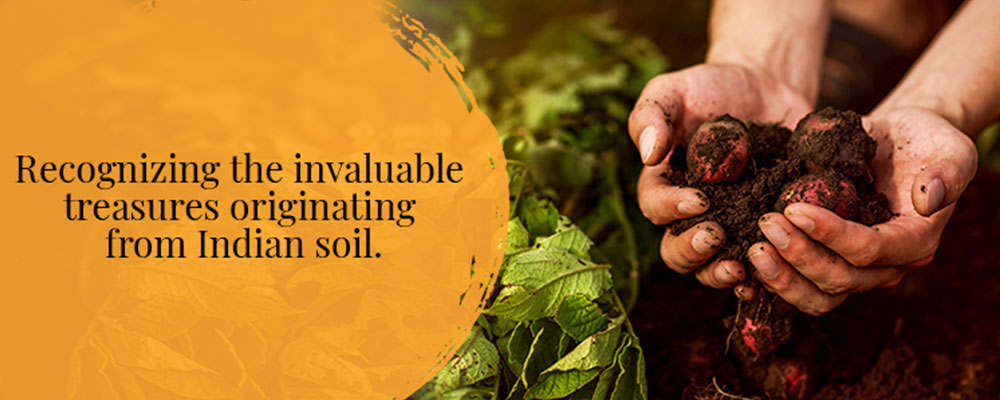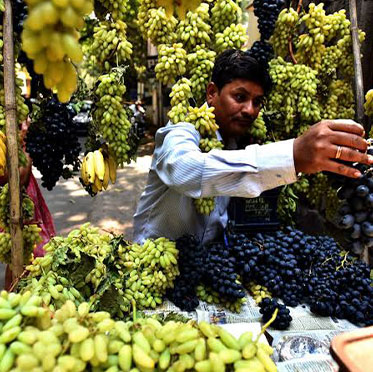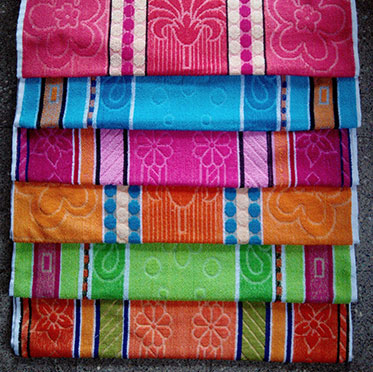






Marathwada Kesar Mango
Kesar variety of Mango was released by Balshad District of Gujarat and brought to Marathwada division of Maharashra. Kesar Mango in Marthwada contains higher amount of total soluble solids i.e. 240Brix which is hight among all mango varieties in India Kesar Mango in Marathwada possesses color and taste similar to Saffron.
In Auragabad, Kesar mangoes are cultivated in Paithan and Sillod talukas. However maximum land under cultivation for Marathwada kesar mango is in Nanded district which amounts to approximately 29,000 hectares followed by Aurangabad.
It has the largest size in Marathwada division with the yield per hectare being more than Alphonso along with nutrient value.
Historically, we see the evidences of Kesar Mango in the 12th century wherein Manubhav Sect, propagated the cultivation of the same in the drought prone Marathwada. To promote this variety, under the Indo-Israel Co-operation, Centre For Excellence for Kesar Mango has been set up in Aurangabad. View Vendor List...

Paithani Saree & Fabrics
Paithani Sarees are made in the Paithan Taluka of Aurangabad. However their production is slowly shifting to Yeola Taluka of Nashik. Paithan Sarees are also known as Mahavastra since they are regarded as a must for all marriage ceremonies. Paithani Saree and Fabrics received the GI Tag on September 3, 2010. Historically, Paithan Taluka in specific is known for this uniqueness since the last 2000 years. During Satavahanas, Paithan was the centre for Zari and exporting centre of silk to Roman Empire. Satvahana ruler named Shalivahana promoted the growth of this craft. Later on Vakatakas, Rashtrakutas, Tughlaq, Mughals and Marathas all propagated Paithani Sarees and Fabrics. Paithani Sarees and Fabrics use zari are 100% handmade and can last for upto 100 years. The designs are inspired from Ajanta paintings and take months to complete. View Vendor List...



Karvathi Kati Tussar Silk Sarees
Karvathi Kati Tussar Silk Sarees are exclusively handwoven in the Vidarbha region of Maharashtra. Not just weaving the saree, but the entire cycle ranging from the cocoon breeding to cocoon processing to drawing out tussar threads, is carried out by the local population.
If the border of the saree is noticed, it has small temple like features (like the Vimana). This drives inspiration from the sculptures at the Ramtek Temple, few kilometres from Bhandara. This gives the saree a popular religious flavour too. They are not only worn at important household rituals or functions but also worn by the ‘Vidarbha Bride’.
Karvathi art is now being extended to cloth pieces, dress material, shirts and dupattas. Tussar silk is easily available in the jungles nearby as Vidarbha is a heavily forested region. This made the use of tussar silk traditional but nowadays, different materials like bamboo silk and mulberry are being used. View Vendor List...

Lasalgaon Onion
Lasalgaon is the largest market for onions in India as well as in Asian landmass. Lasalgaon onion has strong smell and a more pungent taste due to high hight percentage of Sulphur in the Lasalgaon soil. The size of onion bulb of Lasalgaon light red variety is bigger as compared to other varieties. This variety has approximately 16-17 layers of outer dried intact scales which leads to strong protection of inner bulb of onion.
Lasalgaon light red onion variety is well known because of its light red colour, pungent taste, shelf life and its big size. The atmosphere and soil profile of this region are exceptionally appropriate for this Onion.
The catchment area of the Lasalgaon Onion is just one Gram Panchayat of Lasalgaon in Niphad taluka, covering a small population of about 25 thousand. However, more than 60% of onion in the country is traded from Lasalgaon. The proprietors of Lasalgaon Onion are all the farmers who produce the unique variety of onion in that area. The required soil, climate and rainfall make a very unique combination to restrict the production of the light red onion variety only to this 6.09 square kilometre area of Lasalgaon.View Vendor List...



Nashik Grapes
Nashik Grapes is a variety of grape produce in Nashik district, which is known as the ‘Grape Capital of India’. Nashik contributes to more than half of the total grape export from the country.
Nashik is the main area when contrasted with entire world in which harvesting is done during February to April. Further, Nashik is the main district that lies close to 20 degrees and produces good quality of grapes. Other International regions lie somewhere in the range of 30 and 40 degrees.
The Nashik Grapes are produced almost in the entire district due to its conducive climatic condition. Out of the 15 talukas in Nashik, about 12 of them are involved in the production of Nashik Grapes which include Dindori, Niphad, Nashik, Kalvan, Igatpuri, Peith, Sinnar, Yeola, Nandgaon, Surgana, and Malegaon.
The Cooperative Partnership firm ‘Mahagrapes’ was established in 1991 with the objective of boosting the export of grapes by erecting facilities like pre-zones (AEZs) for grapes have been set up to promote the crop so that abundant raw material is available at low cost.View Vendor List...

Nashik Valley Wine
The principle highlight of Nashik valley wine is that since it is created on a high height of around 2000-2400 feet, the grapes have great causticity which is reflected in the wines giving an ideal parity to the readiness characterised by liquor.
Nashik Valley is the largest producer of wine in India, giving Nashik the name of “Wine Capital of India”. Since the protection regulations state that 80% of the grapes must be of Nashik origin along with the packaging, it has led to a persistent improvement in the socio-economic status of the people involved in the value chain.
The geographical location mentioned for the registration of Nashik Valley Wine is Dindori taluka in Nashik district. However, the GI tag was first registered in the name of Dindori Wines which was later changed to Nashik Valley Wine looking at the expanse of wineries located in multiple grape producing talukas of Nashik, especially Niphad, Dindori and Nashik where the table grape variety of Thompson Seedless is prominent.
The proprietors of this product are the different wineries located in the Nashik Valley region, led by the Sula Vineyards. View Vendor List...



MAHABALESHWAR STRAWBERRY
The famous hill station of Maharashtra, Mahabaleshwar, is the abode of strawberries. Located in Western Ghats, it has rich and diverse flora fauna. Standard Percentage of glucose in strawberry is 7%. Mahabaleshwar strawberry, it is up to 10%, which makes it naturally sweeter. The red colour of mahabaleshwar strawberries is maintained due to the exact amount of heat and sunlight available in Mahabaleshwar, whereas, the colour of other strawberries is reddish-brown due to inadequate heat and sunlight.
The Australian Strawberry was introduced in the year 1920. The socio-cultural history cannot be separated from the geographical features including soil and weather conditions. The Cool climate and the fertile red soils thus are the perfect combination for superior quality of the product and distinct taste. Today many farmers have developed their own variety. Their saplings come from California.
Mahabaleshwar Strawberries are the bright red juicy berries whose cultivation is done by local farmers in Mahabaleshwar, Panchagani and Wai. The processing units in the area are Shriram Fruit Processing and Bhilare Mahabaleshwar Cooperative Society Limited.View Vendor List...

Waghya Ghevada
Waghya Ghevada also called as Koregaon Waghya Ghevada falls in the family of beloved rajma savoured by several northern states of India including the capital city, Delhi. This variety takes its name from the unique red lines it has on its faint pink surface which resembles tiger skin. That is why the name Waghya Ghevada. It is found in the Koreagaon taluka of Satara District. Jai Tuljabhavani Shetakari Bachat Gat, Deur applied for its GI tag in the year 2014.
Waghya Ghevada was not native to the region. It was first introduced in the year 1950 by Kashiram Mahajan, one of the farmers of the region, who brought seeds from Pune. The North Koregaon thus became the starting point. Since then Mahajan family descendants have been witness to its popularity and growth. The French bean is sweet in test and extremely rich in proteins. Being a drought resistant variety it requires less water and cycle is of 78-80 days. View Vendor List...



Solapur Chaddar
Solapur Chaddar, is a variety of bed sheet manufactured from cotton in the Solapur district of Maharashtra. Their unique designs and long term usability has made them quite popular across the country, and the Chaddar was the first product to be bestowed with the Geographical Indication status in the state of Maharashtra.
Known for its apparel and garment industry, Solapur once had some of the biggest spinning mills in Asia, and the weaving industry is said to have begun during the rule of the Peshwas. A large number of small weavers were a part of this industry, and the head of each artisan family handled the few looms that they had. Most businesses were family owned, and the women and children in the family helped the business in the initial processes or sometimes in the dyeing process as well. The advent of the powerlooms and the modern factories in the 1970s had a major impact on the local hand loom industry. The Solapur Chaddar was manufactured by the Padmashali weavers since the 1950s, and the demand for this variety has spread to states like Karnataka, Andhra Pradesh, Madhya Pradesh, Rajasthan as well as to countries like UAE, South Africa, Canada and United Kingdom. View Vendor List...

Solapur Terry Towel
Commonly called as the city of textiles, mainly due to its manufacturing capacity for producing terry towels, Chaddars and a variety of other products, Solapur in Maharashtra has truly developed into a major textile hub. The products like terry towels are manufactured by yarn or fabric dyeing and the looms are either rapier looms, hand looms or power looms. The Jacquard mechanism is applied for production of a variety of designs on the terry towels.
Direct employment is provided to nearly 1,00,000 people and nowadays power looms are mainly used for producing terry towels and other products. Around 3,000 powerlooms are being used in Solapur today and all the major textile products are manufactured on Jacquard type power looms. Nearly 80% of the textile production in Solapur is that of terry towels and napkins and Solapur enjoys a near monopoly like situation as it has a very high share of business in the global market for terry towels that have been made on jacquard power looms and are yarn dyed. Nearly 70% of the global demand for terry towels is fulfilled by the production from Solapur. View Vendor List...



Mangalwedha Jowar
Mangalwedha jowar is a crop grown majorly in Mangalwedha taluka of Solapur, a district in Maharashtra. It is a traditional variety that has been cultivated for hundreds of years not only for producing grains for human production but also for fodder use. The Mohol Research Centre in Solapur also selected this local “Wan” variety in 1930 for creating hybrid varieties of Jowar. Mangalwedha jowar thus has a history of hundreds of years as even before 1930 this variety was the major one being cultivated in the post monsoon season.
Mangalwedha jowar, renowned for its unique taste which is a little sweet, and its nutritional value, has a grain which is bold and lustrous and also has a thin pericarp. It provides a good quality as well as yield making it suitable for both grain and fodder use. The grain is also produced in other areas besides Mangalwedha, but the original seeds from Mangalwedha need to be used after every few years to maintain originality of the variety as it undergoes hybridization. Various varieties have been developed by ICRISAT by using the genes from this variety called the Mangalwedha Maldandi (M-35-1). It also contains a high level of glucose, thus giving it a sweeter taste and people in Maharashtra generally prefer the roti made from Mangalwedha jowar due to its good taste and softness. View Vendor List...

Solapur Pomegranate
Solarpur is known as the Pomegranate city for its high level of pomegranate production. High temperature and low moisture content in the atmosphere for sufficiently long period of Solapur District is responsible for obtaining unique sweet taste with desirable acidity of Solapur Pomegranate. Solapur Pomegranate has TSS-16.100 Brix and Acidity 0.45% (cv. Ganesh). TSS-15.95 Brix and Acidity 0.50%(cv. Bhagwa). Solapur Pomegranate is heavier and has more number of arils than other Pomegranate varieties.
Pomegranate is a popular dessert fruit, with other names like “Anar” or “Dalimb” in local parlance. Solapur produces nearly 85% of the pomegranate production of Maharashtra.
It was introduced as a cash crop in Solapur in 1974 by Mr. Prabhakar Chandane, a leading farmer from the Sangola tehsil of Solapur. Due to the drought like situation in Solapur in 1972, demand for growing pomegranate increased as it is a hardy plant and can generate good returns even in tough conditions. As less rainfall is received by the Sangola taluka, it was the first one to be selected for pomegranate cultivation and nearly 1400 of them were planted there in 1974.
Nearly 3 Decades ago, the pomegranate cultivation in Solapur spanned nearly 1850 ha., producing around 11000 tons of pomegranates, but after 1975 the production has increased tremendously. The area under pomegranate production has expanded significantly and now the fruit is also being exported to countries like UAE and UK, and a sophisticated a trade network has developed between the local producers and the international buyers. View Vendor List...





